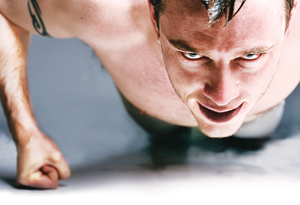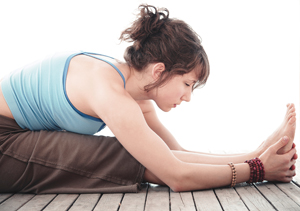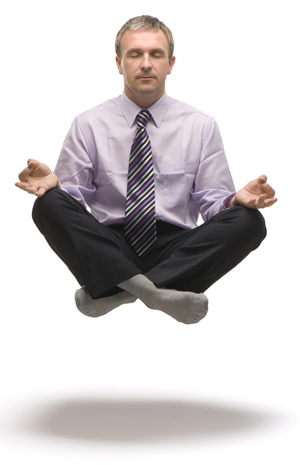Features & Columns
The Yin Crowd

JUST LAST WEEK, I found myself in a rather cute studio in downtown San Jose, a remodeled warehouse with brick walls and highly polished wooden floors. The color scheme was earth tones, and the whole effect was very calming and soothing. Soft music played in the background. Veronica Cruz, a small, young-looking woman, gracefully moved through a variety of different yoga poses as if she were doing a slow dance.
Cruz is the owner of San Jose's Downtown Yoga Shala, which opened its doors on South First Street a few months back. On this early Thursday afternoon there were only five students in the class, ranging in age from mid-20s to late-50s. A wide range in experience was obvious as well.
I was the undoubtedly the newest arrival to the world of yoga, as anyone could tell from my wobbly legs—and the fact that Cruz came by every few minutes to adjust my stance or give me a few tips.
As we stood in position—some strongly, others awkwardly, all breathing deeply—I kept thinking to myself: "Just a little longer. You can do this. Your leg won't really fall off. How nice and relaxed Veronica looks while she tortures me!"
After a little over an hour, my whole body felt like it had gotten a serious workout. Although there were no quick movements or jumping around, I was tired and a bit sweaty. But it was also soothing. I left feeling pretty good about myself.
I woke up the next morning in complete pain. My back and neck hurt, and my legs felt like I'd run a marathon. I guess it's a good pain.
Cruz says San Jose is just now catching on to the yoga scene that is becoming more and more popular. In California and elsewhere, yoga has taken the fitness movement a few levels deeper.
"The breath is the connection between your mind and your body," Cruz says, explaining the most fundamental truth of the discipline. "The health benefits are more than just physical. They're also mental, emotional and spiritual. Because when you have a calm mind, you take that out into the world and deal with whatever is thrown at you."
Afterward, I did feel calmer. I felt very relaxed.
Cruz offers different types of yoga at her downtown studio, and gets a very wide type of clientele. She was surprised that few San Jose State students show up, but she gets a lot of local residents and downtown workers. "When they're constantly bombarded with stress they find yoga a way to counteract that stress.
"But the ultimate benefit is holistic," she says. "Your whole being changes—including how you relate to people, how you view your world, how you deal with things that come up in your daily life. Because you're coming from a calmer place. Because you're coming from a state of being that is centered and grounded. There's clarity. What it brings is beyond the physical benefits."

Holding Strong
Gentle yin yoga takes a few poses a long way to go deep
By Janet Kinosian
A SOFTER, gentler form of yoga seems to be quietly on the rise. From Los Angeles to London, so-called yin yoga is increasingly being taught at studio classes and yoga retreats, not to mention via books and DVDs.
The power or "yang-styled" yoga forms so popular in the West, with their fast shifts between poses and emphasis on sweat, have left a gap for more meditative, longer-held stretches, says Paul Grilley, a martial arts and yoga practitioner who helped develop the yin yoga style along with fellow proponent Sarah Powers.
He says yin yoga is not a new form, but rather a return to more meditative, traditional yoga. Slower forms, such as restorative yoga, already exist, he acknowledges, relying on props to aid with poses and encouraging students to stop when they start to feel discomfort.
But with yin yoga, he says, the emphasis is not on a lack of pain, but rather on how to feel discomfort, stay with it and move through it.
Yin yoga relies on several core poses that, on first look, do not appear difficult. Most focus on the lower half of the body, such as the hips, pelvis, inner thighs and lower spine. The difficulty lies in the length of time the poses are held without shifting or movement.
Each pose is held from two to 20 minutes, and long, deeply held breaths coincide with the stretches. This provides for a meditative and mind-clearing practice that helps practitioners learn how to focus on the moment, proponents say, thus reducing anxiety, tension and stress.
Some of the names and yin poses are similar to their yang counterparts, such as "corpse pose" and "child's pose," though most have been altered and renamed.
The faster-paced yang-style yoga, such as ashtanga or vinyasa, targets lengthening and strengthening the muscles, says the Oregon-based Grilley, who teaches yoga nationally and internationally and wrote Yin Yoga: A Quiet Practice in 2002. Taoist-based yin yoga targets the connective tissues, ligaments, joints and synovial fluid and the energy channels or meridians that the philosophy hypothesizes runs through them.
Adds the San Francisco–based Powers, "This means that instead of coming into a pose for a short amount of time and hugging the bones close together by engaging our muscles, [one] needs to pull the skeleton apart nonaggressively and with appropriate pressure, and then remain stationary a while, allowing the muscles to remain stretched but without engaging them."
Yin poses are not an attempt to stretch the ligaments and connective tissue but to load them appropriately, she says.
Kelly McGonigal, a yoga instructor and psychologist at Stanford University and the editor of the International Journal of Yoga Therapy, elaborates.
"The fourth minute [of a stretch] is not like the first," she says. "If you pull something fast and hard, you don't get a benefit. But if you keep applying moderate, slow and longer pressure, it will eventually relax."
Yin yoga's proponents say the physical effects can have a profound emotional component as well, by teaching practitioners how to handle discomfort and strong sensations. For that reason, yin yoga is being used in some addiction- and trauma-recovery programs.
Dina Amsterdam, a San Francisco–based yoga teacher who teaches yin retreats nationwide, says she's found that this form of yoga has emotional and spiritual benefits that "really outweigh what you'd think the benefits could be for a seemingly simpler practice like yin." The centered and contemplative breathing seems to help release emotion, much like thawing ice, she says.
Also, because much of the stretching is done when the body is cooler, as opposed to yang yoga, in which the muscles have been warmed up, the resulting discomfort helps train the nervous system to be less reactive to the stress of a stretch, McGonigal says.
Molly Lannon Kenny, founder and executive director of the Samarya Yoga Center in Seattle, says this form of yoga is especially rewarding for eager-to-recover addicts and trauma survivors because of the need to work through the discomfort—basically waiting it out.
"For addicts, when they feel that overwhelming, I-have-to-have-that sensation—i.e., I have to have that cigarette, food, drink, drug or whatever—they learn to feel it, sit with it and see how this challenge unfolds, and see that it [both the physical discomfort and the emotional tension] can indeed pass safely," she says.
As for the injury potential in muscles that aren't warmed up, South Bay yoga instructor Via Page says, "Yin yoga poses are long, held stretches, so no warming up is necessary. Actually, the yin yoga poses themselves are essentially a warm-up practice."
As for those emotional benefits, they're not limited to those who have suffered trauma, Page says. "I've had many students tell me it's helped them learn to become more deeply relaxed and less angry and stressed-out all the time," she says.
That doesn't mean yin yoga stress on inner de-stressing will overtake the hotter, sweatier yang.
"Yin yoga might be a hard sell in an environment where students want a real cardio experience," Page says, "but despite this, yin is growing and will continue to grow. Once students get started, they can easily see the benefits of adding yin yoga to the mix."
It's important to remember that we need both yin and yang, she points out. "Yin makes us very flexible and helps us with a more spiritually meditative way of doing things, but we need strength-building, as well. We need them both."

Some Like It Hot
Bikram yoga turns up the heat
By Jackie Johansen
THE BOTTOMS of my feet are sweating, and I have only been here for a half-hour. "Keep breathing," I tell myself. "You can get through this." I reach my arms up into half-moon pose, stretching out my spine while breathing into the space between my vertebrae. It is hard, but it feels good. I stretch down, chest flat against my thighs, pulling forehead to feet. "How can I make it for an hour and a half?" I think to myself. "It is only getting hotter." Just as I think the heat is working against me, it does just the opposite. The warmth penetrates my skin and my muscles. I am able to stretch farther than I expected.
Bikram yoga, known as "hot yoga," is a series of 26 postures with two breathing exercises that are done in a 105-degree room softened with 40 percent humidity. The heat is there for a purpose: to cleanse the skin, protect the muscles by keeping them warm while stretching and to detoxify the body from the inside out. The class is designed for everyone from beginners who have never entered a yoga class to the most meditative and flexible yogis. Bill Butcher, owner of Bikram Yoga Studio of Santa Rosa, explains, "Bikram [Choudhury] designed this series to work every part of the part, every muscle, tendon and internal organ, whereas someone can practice a different type of yoga and leave not having worked the entire body."
Now 63, Choudhury started doing yoga at the age of 4 in Calcutta, India. After winning the National India Yoga Championship at age 13 and being undefeated for three years, he was injured by a weightlifting accident and told he would never walk again. By continuing to practice yoga, he not only was able to walk again but was completely recovered in six months. Convinced of yoga's healing power, he developed his unique series of postures designed for optimum benefit, opened schools in India and eventually brought his series to the United States.
When Butcher took his first Bikram class in 2001, he had been a runner for many years and had his own knee problems. After discovering Bikram, he strengthened his knees and lowered his blood pressure and stress. "This is a challenging workout," Butcher says, "but when I am done, I feel better, less stressed." He has now been teaching for six years and continuously still practices.
Choudhury has been criticized and dubbed the "bad boy of yoga" for declaring that his classes are "torture chambers." He has also been vilified for copyrighting his series of postures, for his net worth of $7 million and for suing teachers who don't adhere to his regimen. But Butcher argues that "any person who becomes successful has critics. The fact is that Bikram has more people doing yoga all over the world than anyone else; he is teaching yoga to the masses, because he is teaching yoga that anyone can do. It is not tricky.
"The fact that he copyrights his series is good," Butcher continues. "It protects what he is doing and prevents people from teaching his method who have not had the proper training."
As I am in the hot room sweating through every pore of my body, stretching my spine backward, which I rarely do outside of a yoga class, there are times when I feel nauseous and exhausted. I wonder why I am putting myself through this. This class is hard, really hard, but it leaves me wanting more. The nausea and exhaustion pass, and I am proud of myself for sticking it out. Energy surges through my body as I push myself through the discomfort. As an alchemist might say, we need the heat to break up what has become concrete and solid within us. With the heat, I am able to move my body in ways I had not expected, I feel rejuvenated and clean from the inside out, calm and relaxed.
Butcher says, "Bikram is trying to get as many people as possible to do yoga, because when we practice, we are nicer, and those around us are affected by it.
"Yoga makes the world a better place."

Law of Yoga
Is teaching yoga a vocation or an avocation?
By Tori Masucci
TEACHING yoga can seem as easy as slipping on a pair of hempen pants and directing others with confident mastery in downward dog. Or it was, until the government became involved.
In January, government regulators in over a dozen states began sifting through an online national registry of yoga training schools created by the nonprofit Yoga Alliance, looking at the industry as a trade group that should be regulated like the vocations of massage, truck driving, dental assisting and others.
In April, uproar on the East Coast continued as the New York State Education Department warned 80 schools that they would face a $50,000 fine if their teacher-training programs were not directly suspended.
On July 4, passionate New York–based yoga educator Leslie Kaminoff launched his own form of Independence Day for yoga when he founded the Independent Yoga Educators of America. To back himself, Kaminoff wrote "A Declaration of Independence for Yoga Educators," which lays claim to protecting the rights of the nation's yoga teachers to independence from any authority that chooses to impose its regulations upon "the yoga community."
But why the push for regulation in the first place?
The culture of yoga has changed in the past decade. No longer is it practiced only by the earth-loving offspring of the hippie movement. Yoga is a full-fledged pop-culture sensation, joining an outstretched arm to the green movement and creating a $6 billion industry that has yuppies, toddlers and retirees alike among the estimated 16 million people in the United States who practice yoga.
The 200 hours a student needs to become a certified yoga teacher is standard throughout the nation, but the lines between regulating different types of yoga instruction are hazy.
Jean Sutton, founder of BodyWorks Yoga in Petaluma, explains that many yoga studios and health clubs are now employing "gym yoga" in their classes, which can be taught by instructors who have not necessarily had formal yoga training.
"This style of yoga is approached as strictly exercise, which isn't what the yoga system is about, and many injuries have occurred," Sutton says. "The need for regulation may have stemmed from this."
Soon after the New York debacle, California put mandatory licensing for yoga training schools into question and began scrutinizing the curriculum and refunding policies that these schools use, in an effort to ensure they are legit. The state does not currently regulate or license proprietary vocational schools at all.
As a certified yoga instructor, Sutton understands the concern.
"I was pleased to hear that certain states were looking into using guidelines," she says. "They've done a lot of work trying to get standards set, and I think they've done a good job of trying to accommodate many different styles and philosophies. I feel like many schools have already set these policies for themselves, though."
Like many of her counterparts, Sutton remains a yoga purist. "By all means, being a yoga instructor is a lifelong learning experience," she says. "It's an interesting dilemma for the whole yoga industry. The rebellious side of me feels that just because yoga has taken a big boom, the government wants to regulate it. But how do you regulate this 5,000-year-old practice?"
As states continue to crack down on yoga schools, it is likely they may begin to weed out small programs and studios who cannot live up to teaching standards, or who simply cannot afford to.
"I'm registered through the Yoga Alliance for the particular interactive yoga therapy program that I run for teacher training," Sutton says. "I'm really pleased with what we offer, and it does provide a really thorough 10-month training. In my case, it would probably work out OK and my studio wouldn't be affected."
For now, in light of hovering government policies, wannabe yoga instructors will need more than taut muscles and adept flexibility to earn their certifications and gain credibility. But state bureaucrats had better believe that yoga enthusiasts won't go into a corpse pose over this one.
Renewbie
Even karma gets stretched when one returns to the mat
By Suzanne Daly
I STRAGGLED out of the cold, foggy morning into the cavernous gymnasium and blinked as my eyes adjusted to the buzzing fluorescent lights glaring overhead. Along with the other students, I aimed for the island of athletic mats grouped on the scuffed wooden floor, then arranged myself on a towel to distance myself from the odor of sweat lingering on the maroon plastic.
Dressed in an array of T-shirts and cutoffs with long johns underneath, baggy sweats or the occasional leotard and tights with legwarmers, we took note of each other and of the pretty, blond thirtysomething teacher who awaited us. Linda, who preferred to be called "Devi," sat in a perfect lotus position, an air of serenity around her. She lightly tapped her Tibetan gong, sending a low clear note echoing through the frigid gymnasium.
I was 18, just entering nursing school at the local community college, and needed the morning class to calm my fears before learning to give injections and enemas, to insert tubes into bodily orifices. We started off with deep cleansing breaths, inhaling positive energy and exhaling the negative. "Rock and rolls" followed, as we curled up on our backs like little pill bugs and rolled the kinks out of our spines. We saluted the sun, gracefully dipping and breathing, stretching our lithe bodies as Devi's soft voice called out the pose. I could easily bend forward with legs straight, head to knees, palms flat on the mat.
As Devi instructed us to go deeper into the stretch, my breath carried away whatever tension I may have acquired at that tender age. No sweating was involved, and most of the strain I experienced was to keep from laughing at the young male students attempting to squat past a deep knee bend while keeping their footing on the slick mat. I knew that comparing our agility wasn't the righteous yogic thing to do, but I was young and always looking for the fun in life.
We concluded the class either with a relaxation exercise, tensing then releasing each individual body part, or an asana to energize us for the day. One morning we ended with the "woodchopper." Holding imaginary axes high overhead, we forcefully swung them downward while squatting, making contact with our imaginary log.
A loud ha! accompanied the movements, expelling any remaining tension. As my friend Vicki went down for her third chop, we heard a loud tearing sound, and she quickly stood, red-faced, her pants ripped down the seam. Luckily, her fringed poncho was long enough to cover her mishap, and the ha!s dissolved into laughter.
Fast-forward three kids, 30-plus years and pounds later, and I find myself heading to a yoga studio for a class, courtesy of a gift certificate. Feeling reasonably fit due to the aerobic classes I have been devoted to for five days a week for years, I know the beginner's class will be a breeze.
The studio is intimate, with polished bamboo floors and wall lights thoughtfully covered in gauzy lavender fabric to soften the glow. A full wall of cubbies is filled with jewel-toned yoga "props": green foam blocks, blue wedges and mats, purple blankets, beanbags, bolsters and straps. The students mosey in, unrolling their mats from hemp shoulder bags, collecting props and greeting the petite, highly toned teacher.
Dressed in an array of yoga apparel made from breathable, organic bamboo jersey with natural antibacterial and deodorized elements, they choose their spots and start to stretch. My worn spandex sticks to me, as does the mat beneath my feet; I can almost hear the suction noise as I position myself.
We start with deep breaths and then are instructed into an asana that sounds foreign to me, due to the teacher's quiet voice and the Sanskrit name. I crack my eyes, trying to follow along by watching what's going on around me. "Hold the pose," we are told. "Tighten your core."
Very specific instruction regarding each muscle and its corresponding energy path is given as rivulets of perspiration course down my back. I struggle to keep my knees straight while my palms dangle inches off the ground. I have never sweated so much while holding still. My yogic karma has caught up to me as I remember my mirth at those poor, unlimber guys in the gym 30 years before. I stick out the rest of the class, both literally and figuratively, and breathe a deep sigh of relief when it ends. Namaste, indeed.
Yoga Studios
Campbell
Sherry Han's Yoga Center
1627 S. Bascom Ave., Campbell; 408.978.3832
Yoga Fitness
1 W. Campbell Ave., Bldg. B, Room 29, Campbell; 408.777.9642
Cupertino
Northwest YMCA
20803 Alves Dr., Cupertino; 208.257.7160
Los Altos
Yoga of Los Altos
343 Second St., Los Altos; 650.941.9642
Los Gatos
Anastasia's Club Fit
15445 Los Gatos Blvd., Los Gatos; 408.358.5076
Los Gatos Health & Fitness
285 E. Main St., Los Gatos; 408.354.5808
Los Gatos Swim & Racquet Club
14700 Oka Road, Los Gatos; 408.356.2136
Yoga Center of Los Gatos
9 Montebello Way, Los Gatos; 408.761.3914
Yoga Source
15545C Los Gatos Blvd., Los Gatos; 408.402.9642
Milpitas
Lifestretch Yoga Studio
146 S. Main St., Milpitas; 408.262.9642
Also at 37353 Fremont Blvd., Fremont: 510.796.YOGA
Mountain View
California Yoga Center
570 Showers Dr., Suite 5, Mountain View; 650.947.9642
Yoga Is Youthfulness
590 Castro St., Mountain View; 650.964.5277
Palo Alto
Ananda Yoga Center
2171 El Camino Real, Palo Alto; 650.323.3363
Avalon Art & Yoga Center
370 S. California Ave., Palo Alto; 650.324.2517
Balance Center
560 Oxford Ave., Palo Alto; 650.856.2000
California Yoga Center
541 Cowper St., Palo Alto; 650.947.9642
Darshana Yoga
654 High St., Palo Alto; 650.325.9642
Equinox Fitness Club
440 Portage Ave., Palo Alto; 408.319.1700
Palo Alto Family YMCA
3412 Ross Road, Palo Alto; 650.856.9622
Yoga Mind Warrior Body
609B Cowper St., Palo Alto; 408.930.7262
Yoga Source
158 Hamilton Ave., Palo Alto; 650.328.9642
San Jose
Bikram San Jose
5289A Prospect Road, San Jose; 408.255.9910
Downtown Yoga Shala
450 S. First St, San Jose; 408.885.1000
NuLife Yoga
25 Dana Ave., San Jose; 408.297.9642
Reformation Yoga
33 Las Colinas Ln., San Jose; 408.284.1300
Soula Power Yoga
200 S. First St., San Jose; 408.993.9642
Willow Glen Yoga
1188 Lincoln Ave., San Jose; 408.289.9642
Santa Clara
Gold's Gym
1900 Duane Ave., Santa Clara; 408.988.4494
Dahn Yoga
5145 Stevens Creek Blvd. Suite 140, Santa Clara; 408.241.0328
Decathlon Club
3250 Central Expwy., Santa Clara; 408.738.2582
Sunnyvale
Han Yoga
587 E. El Camino Real, Sunnyvale; 408.245.YOGA
Planet Granite Yoga
815 Stewart Dr., Sunnyvale; 408.991.9090


